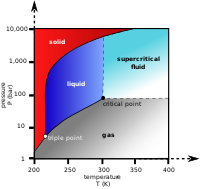
Photo from wikipedia
Carbon dioxide derived polymers are emerging as useful materials for applications spanning packaging, construction, house-hold goods and automotive components. To accelerate and broaden their uptake requires both more active and… Click to show full abstract
Carbon dioxide derived polymers are emerging as useful materials for applications spanning packaging, construction, house-hold goods and automotive components. To accelerate and broaden their uptake requires both more active and selective catalysts and greater structural diversity for the carbon dioxide derived polymers. Here, highly active catalysts show controllable selectivity for the enchainment of mixtures of epoxide, anhydride, carbon dioxide and lactone. Firstly, metal dependent selectivity differences are uncovered using a series of dinuclear catalysts, Mg(ii)Mg(ii), Zn(ii)Zn(ii), Mg(ii)Zn(ii), and Mg(ii)Co(ii), each exposed to mixtures of bio-derived tricyclic anhydride, cyclohexene oxide and carbon dioxide (1 bar). Depending upon the metal combinations, different block structures are possible with Zn(ii)Zn(ii) yielding poly(ester-b-carbonate); Mg(ii)Mg(ii) or Mg(ii)Co(ii) catalysts delivering poly(carbonate-b-ester); and Mg(ii)Zn(ii) furnishing a random copolymer. These results indicate that carbon dioxide insertion reactions follow the order Co(ii) > Mg(ii) > Zn(ii). Using the most active and selective catalyst, Mg(ii)Co(ii), and exploiting reversible on/off switches between carbon dioxide/nitrogen at 1 bar delivers precision triblock (ABA), pentablock (BABAB) and heptablock (ABABABA) polymers (where A = poly(cyclohexylene oxide-alt-tricyclic anhydride), PE; B = poly(cyclohexene carbonate), PCHC). The Mg(ii)Co(ii) catalyst also selectively polymerizes a mixture of anhydride, carbon dioxide, cyclohexene oxide and ε-caprolactone to deliver a CBABC pentablock copolymer (A = PE, B = PCHC C = poly(caprolactone), PCL). The catalysts combine high activity and selectivity to deliver new polymers featuring regularly placed carbon dioxide and biomass derived linkages.
Journal Title: Chemical Science
Year Published: 2021
Link to full text (if available)
Share on Social Media: Sign Up to like & get
recommendations!